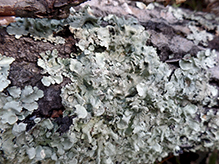Eastern Candlewax Lichen
(Ahtiana aurescens)
Conservation • Description • Ecology • Distribution • Taxonomy
Conservation Status |
|
|||||||
| IUCN Red List | not listed |
|||||||
| NatureServe | NNR - Unranked S3 - Vulnerable |
|||||||
| Minnesota | not listed |
|||||||
Description |
||
Eastern Candlewax Lichen is a medium-sized lichen that grows on the bark of cedar and pine trees, rarely on hardwood trees. It is found in undisturbed old growth forests, where the dense shade, high humidity, and the texture of the substrate (bark), combine to create ideal conditions for its proliferation. In Minnesota, it is usually found in northern white cedar swamps. It often grows alongside American Starburst Lichen (Imshaugia placorodia) on pine trees. The vegetative body (thallus) is leaf-like (foliose) and divided into large branches (lobes). It grows close to but loosely attached to the substrate (bark) by short, pale, sparse to abundant, anchoring structures (rhizines). The lobes may be flat and branching or crowded and overlapping. The upper surface is yellowish-green and usually wrinkled. It does not have powdery dull granules (soredia), shiny granules (isidia), or a chalky or “frosted” surface (pruina). The lower surface is pale brown, smooth, and shiny. Small, lobe-like reproductive structures (lobules) are usually produced on the margins of the lobes. The lobules are round and 1 ⁄64″ to 1 ⁄16″ (0.5 to 2 mm) in diameter. Disk-like, spore-producing structures (apothecia) are usually abundant. The disks are 1 ⁄16″to ¼″ (2 to 7 mm) in diameter, reddish-brown, slightly raised, and shaped like a plate. They appear near the margins on the upper surface. Each disk has a ring of tissue around it that resembles the tissue of the vegetative (non-fruiting) part of the lichen. There are also tiny, globular chambers (pycnidia) embedded in the thallus with an opening through which fungal spores are released. The pycnidia look like black pinpricks in the thalus and are very conspicuous. The photosynthetic partner (photobiont) is green and may be Trebouxia, but lichen photobionts are difficult to identify. |
||
Similar Species |
||
| Yellow Ribbon Lichen (Allocetraria oakesiana) has yellowish granules (soredia) on the margins. | ||
Ecology |
||
Substrate |
||
Trees |
||
Growth Form |
||
Foliose |
||
Habitat |
||
Old growth forests. |
||
Hosts |
||
Cedar and pine trees. |
||
Distribution |
||||
|
Sources The records from Rosseau and Lake of the Woods Counties were in 1901. Eastern Candlewax Lichen is now considered “possibly extirpated” in those counties. |
|||
| 5/29/2022 | ||||
Occurrence |
||||
|
||||
Taxonomy |
|||
| Kingdom | Fungi (Fungi) | ||
| Subkingdom | Dikarya | ||
| Phylum | Ascomycota (Sac Fungi) | ||
| Subphylum | Pezizomycotina (Sac Fungi and Lichens) | ||
| Class | Lecanoromycetes (Common Lichens) | ||
| Subclass | Lecanoromycetidae (Shield Lichens, Sunburst Lichens, Rosette Lichens, and Allies) | ||
Order |
Lecanorales (Shield Lichens, Rim Lichens, and Allies) | ||
Family |
Parmeliaceae (Shield Lichens and Allies) | ||
| Subfamily | Parmelioideae (Typical Shield Lichens) | ||
Genus |
Ahtiana (candlewax lichens) | ||
| Mycobiont | Ahtiana aurescens | ||
| Photobiont | Trebouxia? | ||
Synonyms |
|||
Cetraria aurescens Tuckermannopsis aurescens |
|||
Common Names |
|||
Eastern Candlewax Lichen |
|||
Glossary
Apothecium
An open, disk-shaped or cup-shaped, reproductive structure, with spore sacs on the upper surface, that produces spores for the fungal partner of a lichen. Plural: apothecia.
Foliose
Adjective: Leaf-like growth form; referring to lichens with leaf-like growths divided into lobes.
Noun: The leaf-like, vegetative body of a lichen (thallus) that has thin, flat lobes which are free from the substrate.
Lobule
A small lobe-like subdivision of a lobe. In lichens, a small lobe-like, asexual, reproductive structure produced at the edge of a lobe, breaks off, and reestablishes elsewhere.
Photobiont
The photosynthetic partner of a lichen; either green algae or cyanobacteria.
Pruina
On lichens, a thin, powdery or crystaline deposit on the surface of the thalus. It may appear chalky or frosty, and is usually white, gray, or bluish.
Rhizine
A root-like structure of a lichen that attaches the lower layer to the substrate.
Soredium
An asexual reproductive structure of a lichen in the form of a tiny dull granule on the thallus surface that can be easily brushed off. It consists of a cluster of algal cells (the photobiont) wrapped in fungal filaments (the mycobiont), but without an outer layer of protective tissue (cortex). Plural: soredia.
Thallus
The vegetative body of a lichen composed of both the alga and the fungus.
Visitor Photos |
|||||
Share your photo of this fungus. |
|||||
| This button not working for you? Simply email us at info@MinnesotaSeasons.com. Attach one or more photos and, if you like, a caption. |
|||||
Luciearl |
|||||
 |
|||||
MinnesotaSeasons.com Photos |
|||||
|
|||||

Slideshows |
||

Visitor Videos |
|||
Share your video of this fungus. |
|||
| This button not working for you? Simply email us at info@MinnesotaSeasons.com. Attach a video, a YouTube link, or a cloud storage link. |
|||
Other Videos |
|||

Created: 9/16/2018
Last Updated:


